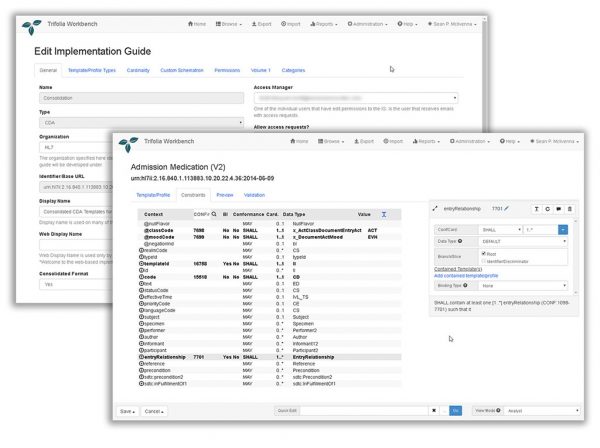
Trifolia Work Bench (TWB) creates CDA® implementation guides, including templates, value sets, narrative, custom validation logic, and samples and publishes them in several formats for immediate use or for ballot in the standard HL7® format.
Last we looked, our Lantana-hosted application had:
Github users are not tracked.
Reuse, Design, Reuse
We designed TWB to automate CDA template creation and optimize reuse of prior work. TWB starts with the base specification and open- access libraries including the US Core Data for Interoperability (USCDI). Users can point-and-click elements and attributes to create new templates, assert conformance to a published template, or modify and create a new version of anything in the database.
Create and Maintain XML
Designers use XML samples to visualize the abstract requirements of the specification. TWB automatically generates complete XML samples for each template or smaller snippets for individual constraints. These can be combined to create a complete sample document.
Define custom validation
TWB generates Schematron rules that create a second layer of validation over the base CDA Schema. Users can also create or customize validation logic as XPATH assertions or define further Schematron rules for advanced validation logic.
Terminology
Identify new code systems and define new value sets or import them from the Value Set Authority Center (VSAC) and Public Health Information Network Vocabulary Access and Distribution System (PHIN VADS) or from Excel.
Import and Export
TWB exports implementation guides in 10 formats, including HTML and MS Word for immediate implementation or HL7 ballot. Users can backup data with a point-in-time export and then import it later to restore the older data.
Publish
TWB can publish online in HTML or in PDF, Word, and flavors of XML, JSON, and Schematron. TWB creates hyperlinks and context tables at all levels in exported implementation guides which supports efficient navigation, review, and maintenance. It creates a table for each value set, and users can select the number of entries each table previews for large value sets.
Role-based Control and Permissions
Users can define user roles and permissions to control who can view and edit templates and value sets. Setting permissions for “everyone” means the full Trifolia user base can reuse your work.
Installation
Access our free-to-use hosted TWB version.
Download and install your own copy from the public code repository on GitHub. Local installation requires:
- Windows Server 2008+
- Microsoft C# .NET 4.5
- OAuth 2.0 Authentication
- SQL Server 2012+
For support, go to Product Support.
For more information or to request a demonstration of any of our software products, contact products@lantanagroup.com.
HL7® and CDA® are the registered trademarks of Health Level Seven International and the use does not constitute endorsement by HL7.
